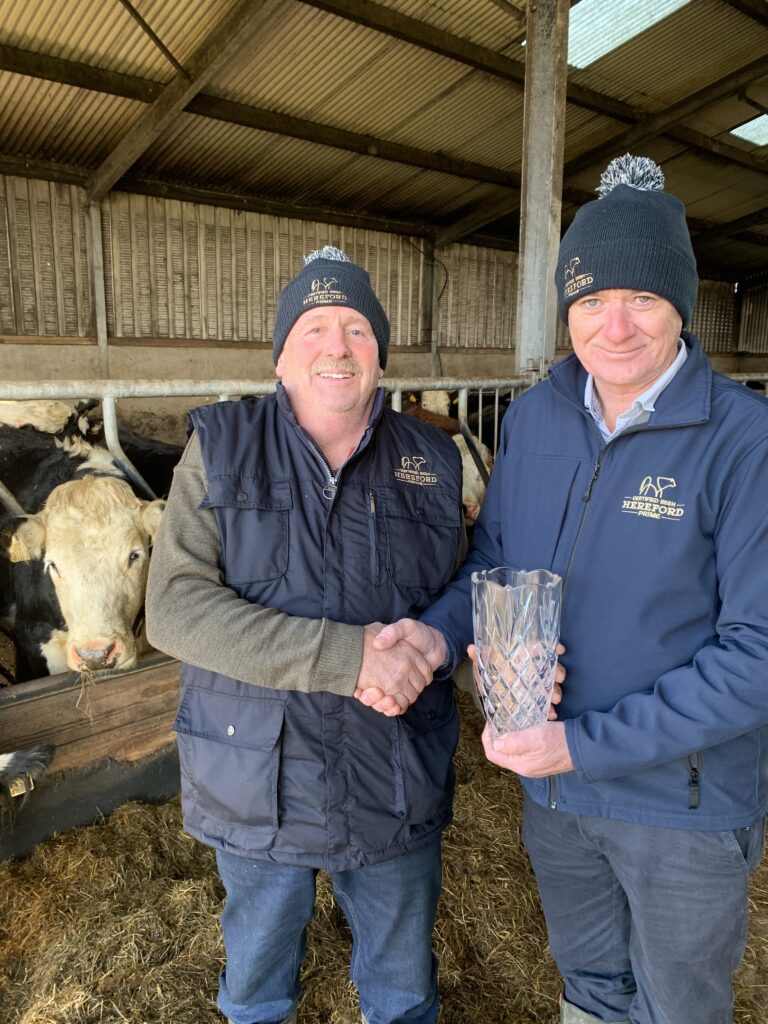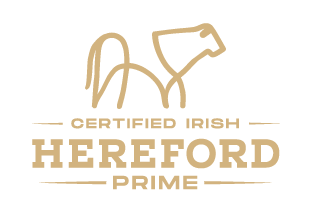The Irish Hereford Prime Farmer of the Year for 2023 is Maurice Hallahan from Grange, near Ardmore in Co. Waterford. Operating a Hereford cross heifer beef system, since he retired from dairy farming over 12 years ago, sees Maurice claim this year’s farmer accolade. Maurice works an impressive and well-run farming system, historically buying between 65 and 75 Hereford cross heifers in as weanlings each year. However, in 2023 he changed his breed profile further and bought in 110 Hereford cross heifers. In 2024 he aims to stock the farm entirely with Hereford cross cattle, and with all things going well, this will mean 150 Hereford heifers on the farm. He keeps them for a period of approximately 12 months, taking them right through to finish at which point he supplies ABP Waterford. Maurice is also a participant in the ABP Advantage Beef Program.
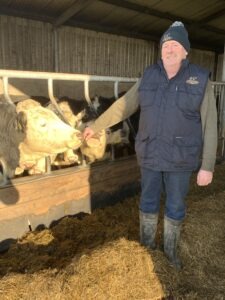
Excellent animal performance is a testament to his grassland management as he believes in striking a balance between grass utilisation and grass quality. When asked why he farms Herefords, his answers are what make us happy to hear; “easy managed, good weights for age, docile and easily finished”. Maurice also points out that he finds it hard to buy other breeds of cattle that can perform as consistently well for him on his farm. The improved animal performance seen on Maurice’s farm from his Hereford cattle, resulting in a reduction of age at slaughter while maintaining carcass weight, makes him a worthy winner of this year’s Irish Hereford Prime’s Farmer of the Year award.
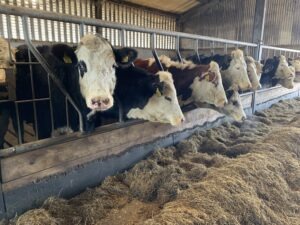
Doing the simple things right
Maurice places huge emphasis on buying quality cattle and he makes the majority of his purchases locally in both Fermoy and Dungarvan marts. Interestingly, over 80% of the Hereford cattle that Maurice slaughters have only one or two farm movements in their lifetime.
Reviewing the performance of Maurice’s herd over a five-year timeframe allows us to see that he has managed to drop the age of slaughter by 41 days in that period, while at the same time not only maintaining carcass weight but actually increasing it by an average of 11kgs. By working in tandem with the procurement team, Maurice has gone from having anywhere from 10-15% of his cattle grading too fat (5’s) pre-2021, to having 100% of his heifers in 2022 and 2023 grading between a 3= and a 4=. When asked what other element of his herd performance he would look to improve, he points out that the minimum conformation grade O= for bonus qualification can sometimes be difficult for him to achieve. His system of production means that he is relying on another farmer to breed the animal for him and buys in all Hereford stock as weanling heifers as he “hopes to be buying potential rather than feed”.
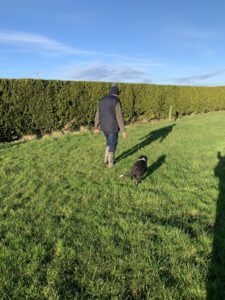
Making great strides in sustainability
The first port of call for Maurice in making any decision for animal treatment or farm management is through testing. He regularly soil tests, takes faecal samples and does silage analysis of both pit and baled silage. He aims to make his first cut of silage most years in mid to late May which tends to provide him with a silage that comes in at 70 to 72 DMD. A feed over the years that Maurice has huge faith in is locally grown fodder beet, which he tends to feed to both his stores at 3-5 kgs and finishing stock at a rate of 14kgs plus 3-4kgs meal.
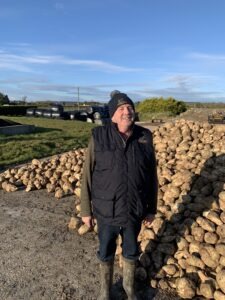
Another key driver for performance for Maurice is “grass, grass, grass”. By using the infrastructure that was in place from when he was milking dairy cows, he is able to give groups of 25-30 heifers two days in a paddock before moving them to fresh grass. He reseeds a portion of the farm every year and looks to include higher levels of clover due to the nitrogen fixation properties that help him to reduce his artificial N requirements.
By grazing cattle outdoors, for a long grazing season, he feels this is giving his cattle the best chance to thrive. Achieving an early turnout, depending on the weather in any particular year, Maurice strives to have stock out by St. Patricks day. Housing usually takes place in November but again the weather plays a huge part in this and unfortunately 2023 did not play ball.
When pressed on his thoughts about where farming is now in general, Maurice feels that dairy numbers have reached their natural limit since the rapid expansion over the last few years and he has a real concern for the viability of the smaller farm in Ireland given the increased costs and low farm income. Despite Maurices excellent sustainability efforts, he does find the current “bombardment with GHG and environmental changes that are being requested nationally for farmers, as being very challenging”.
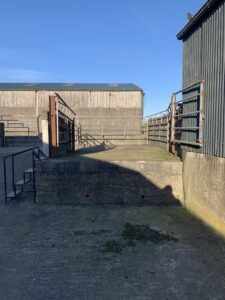
Who is Maurice?
Maurice is the 3rd generation of Hallahans to farm in Grange, near Ardmore which was bought in the early 1900s, Maurice’s father also purchased an additional part of the existing farm in the 1950s. Maurice has three brothers who both help out when needed along with his nephews but in reality, the farm is very well set up with great infrastructure that makes life easy for handling and working with his cattle. The farm and farmyard are exceptionally well maintained partly due to the enjoyment that Maurice gets from welding and making the things the farm needs to stay in good order. A simple but highly effective example is the loading bay and ramp that makes the loading of animals very safe for both man and beast.
An avid reader and golfer, with a keen interest in the GAA, Maurice likes to find time for travel, where he lists New Zealand as being one of his favourite destinations, having worked there in his late teens. On a more recent visit he has seen significant changes to both herd size and landscape than when he first visited.
Maurice aims to play golf twice a week if possible on a Sunday and one day during the week. Recently retired from the role of secretary after twenty-two years in his local golf club West Waterford, home to two touring professional golfers Seamus Power and Gary Hurley – a mention of which is a source of pride to Maurice.
One of Maurice’s earliest farming memories was working at sheep with his father in the rain and getting soaked to the skin (probably one of the reasons that he doesn’t have sheep now!) As was tradition there was an expectation that Maurice, as the oldest son in the family, would take over the family farm but as he says himself, “farming was all I ever wanted to do from a very young age so I’ve had many years of enjoyment doing what I love”.
Similar to the benefits of a co-ordinated approach taken by the Irish Hereford Prime producer group in marketing Hereford beef under one brand, Maurice is a strong believer in the power of farmers coming together. He is part of a local purchasing group in his area that strives to strike the best deal possible for lots of his farm inputs; such as diesel, fertiliser, fencing, veterinary supplies and feed.ahan
In conclusion from Maurice, “Farming as most of us know is not always easy at times, but it is a great way of life. Farming Herefords does help and so they will be part of my farming system for the foreseeable future”.
END.
